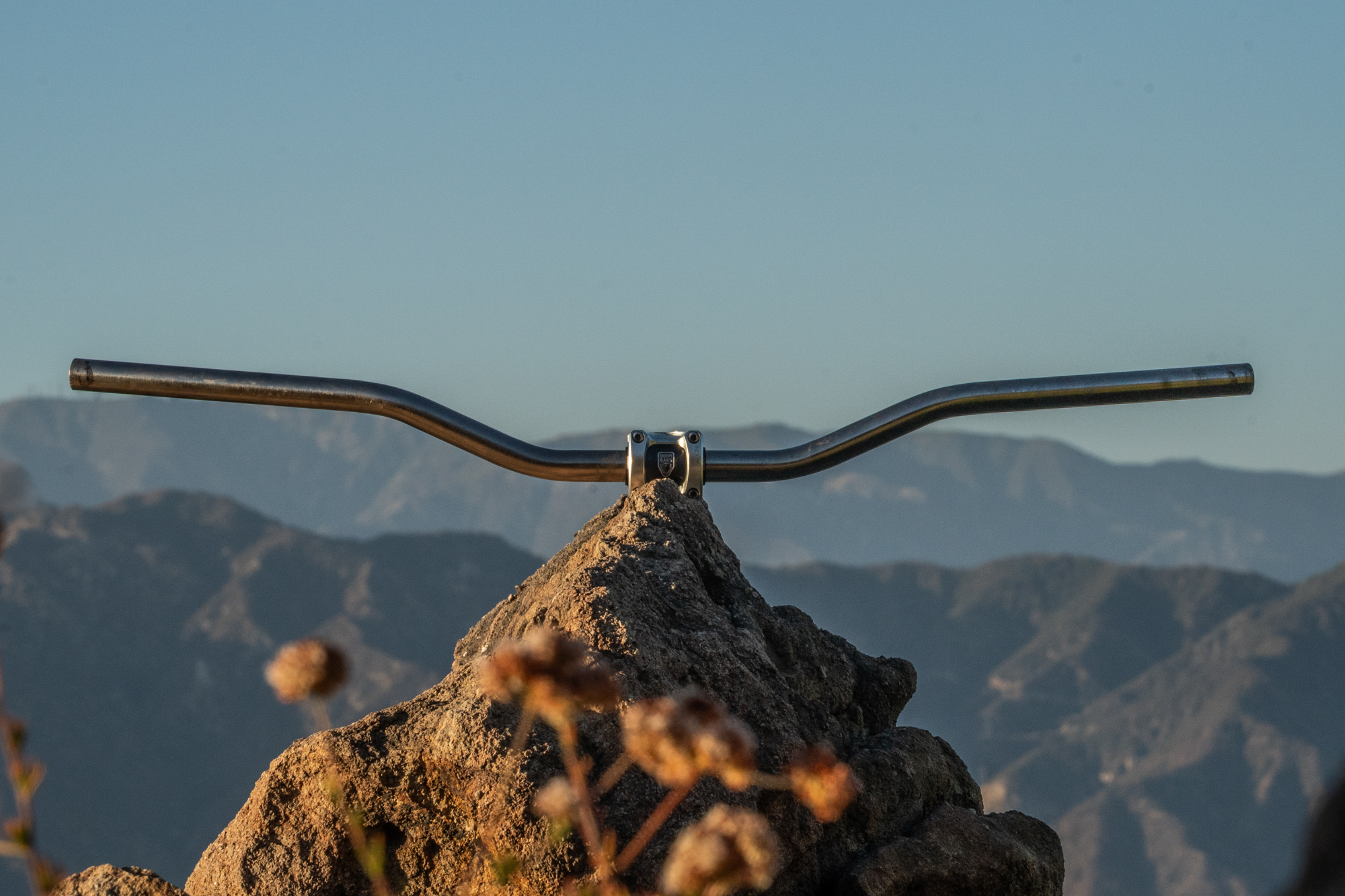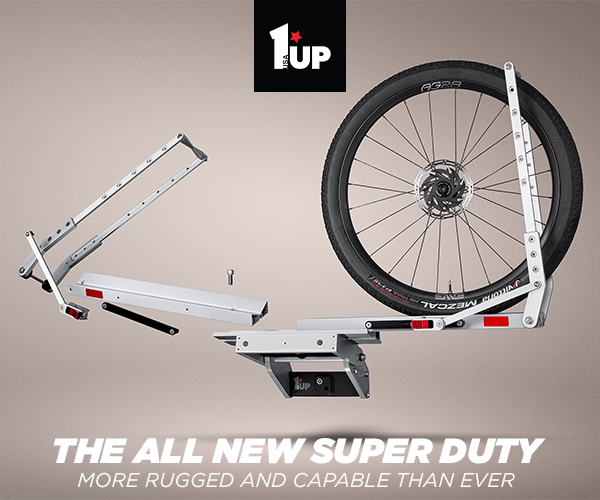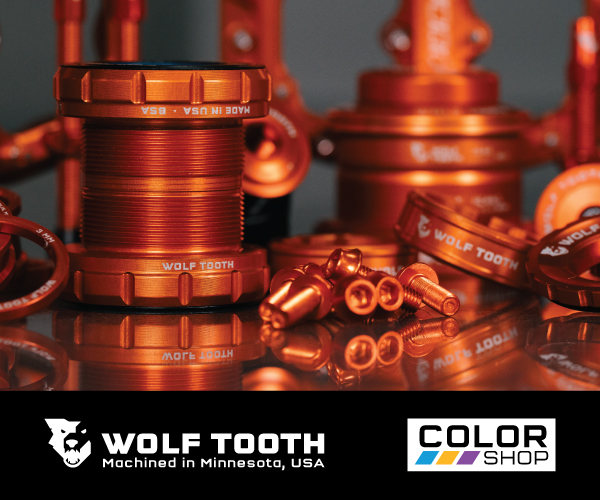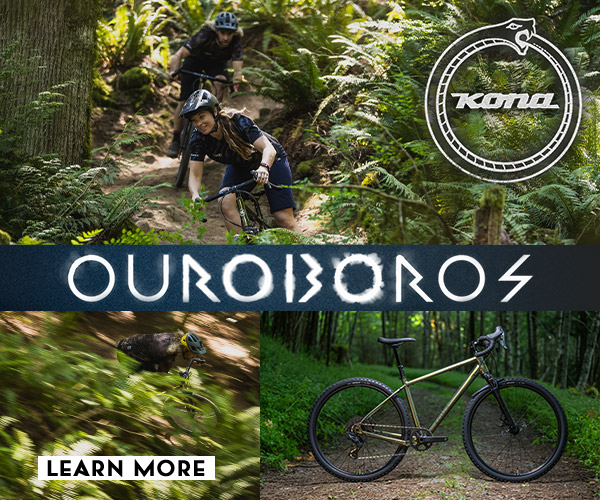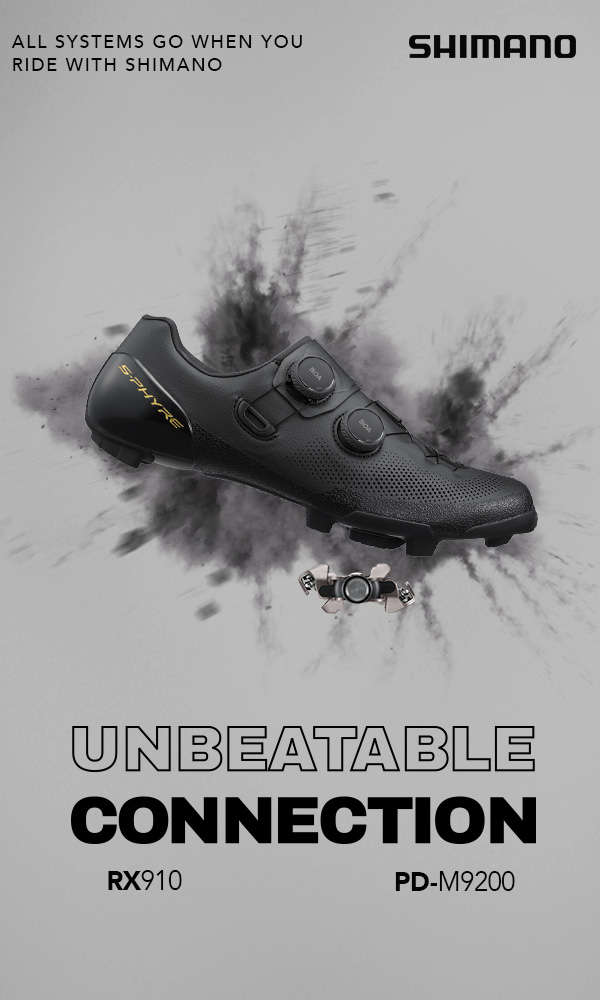Steel handlebars are timeless and elegant. But Travis doesn’t care about that stuff. He owns two pairs of 4130 steel DOOM Lucky Riser bars because they instantly make any mountain bike more capable and more comfortable…

If you put your ear to the trail, you might hear whispers of a revolution. Mountain bike cockpits need to change. Stack heights have been too low for too long, especially if you’re tall, old, or aggressive. I happen to be all three. So, lately, I’ve been running stems with built-in rise. But it’s still not quite enough, unless you count the infamous Raised Reverse stem. And anyway, height is only part of the problem with handlebar positions.
![]()

A parallel revolution is happening in gravel, road, and touring, although “parallel” is definitely the wrong word for it. Our wrists are not comfortable when they’re pointing directly forward or directly at each other. A lot of drop-bar riders are now setting up their brake hoods to look a little cross-eyed, which makes sense logically.
Then there’s the alt-bar movement, which I guess has been around for decades. Yet still, traditional mountain-bike-bar backsweeps rarely pass the single digits. That probably makes sense for the enduro and DH racers who spend their most crucial moments squared-up and elbows-out. But the masses have different needs, and we’re getting restless.

My solution is the DOOM Lucky Riser bars. They’ve got a 50 mm rise, which is impactful but not unsightly. And 14° of backsweep, which feels natural but not lazy. DOOM Lucky Risers come in multiple configurations and multiple widths (see below), but I cut mine down to 800. And while I’m listing numbers, then following them with the word “but,” these bars come in either 4130 chromoly or grade 9 titanium, but I think saving sprung weight is overrated. So, I bought the chromoly ones.
DOOM Lucky Riser 4130 Quick Hits
- 4130 chromoly steel
- 50 mm (2”) rise
- 6° upsweep, 14° backsweep
- 22.2 mm clamp diameter (includes 25.4 or 31.8 mm shims)
- Narrow 31.8 “accessory” shims available for lights, etc.
- Available in two versions:
- Narrow stem-clamp-width: 826mm wide, can be cut to 728mm with a 185mm grip area
- (The black bar pictured in complete-bike photos
- Wide stem-clamp-width: 880mm wide, can be cut to 780mm with a 185mm grip area
- (The nickel-plated bar, pictured off the bike)
- Narrow stem-clamp-width: 826mm wide, can be cut to 728mm with a 185mm grip area
- Available in Endless Abyss Black Powder Coat, Clear Powder Coat with Polished Logo, Nickel Plated, or Nickel Plated with Polished Logo
- Made in Albuquerque, New Mexico
- 585 grams (with shims, cut to 800mm)
- $185

And then there’s the number, 22.2 mm. DOOM bar diameters don’t taper. While that makes manufacturing easier, it also makes for a more compliant handlebar. That’s another thing that I see changing in bike design. For example, while I think tapered steerer tubes are a godsend for aggressive mountain bikers, I hadn’t considered that they compromised comfort for other riders.
Tay recently wrote an insightful and entertaining review of the Ritchey Montebello, which has a straight 1&⅛” steerer tube. That helps prevent the fork’s natural flex from stopping at the bottom headset cup. A straight 22.2 mm handlebar does something similar.


The mountain bike industry unfortunately seems committed to a naturally stiff 35 mm handlebar clamp diameter. With occasional success, brands have clawed back some give using unique shapes and innovative materials. At most, that amounts to an improvement in high-frequency damping, not overall comfort.
And I understand why some riders want to avoid any flex in their bars until there’s a sharp impact. Brands like OneUp and Forge + Bond have done some cool stuff for those riders. I often used their bars on review bikes. They left me with no complaints. Anyway, I didn’t pick up the DOOM Lucky Risers for the feel. I got ’em for the fit.


Speaking of fit, I used the included 31.8 mm shims. You can also opt for 25.4 mm, though there’s currently no 35.0 mm shim available. You could also use a 22.2 mm Paul Box Car stem or a BMX stem. Getting everything lined up and centered with the shims. But given that I own two pairs (black for review bikes, nickel-plated for my personal bike) and have been swapping them often in recent months, I’m probably more sensitive to that than you’ll be.

50 mm of rise is at the tall end of what you’ll find from a traditional mountain bike component brand. Race Face just dropped their 55 mm ERA bars, which are Spencer-approved. ENVE stops at 40 mm in their M7 bar, but offers 50mm in their DH-focused M9 bar.
Interesting side note: Both happen to be the only sizes that are sold out from ENVE at the moment, which I take as more evidence that the revolution is coming. My point is that 50 mm is not extraordinarily tall. You don’t have to be a stacktivist™ like me and Spencer to feel welcomed by the Lucky Riser. John agrees with his recent Old Bike Day post.

The 14° backsweep is similarly welcoming. I’ve ridden Jones and Ritchey bars that float past 20° and feel like novelties; fun, but not as practical as a traditional bar for aggressive riding. The DOOM Lucky Risers split the difference nicely. They seem natural. Reaching for the grips feels far more “lined-up.” It’s like a perfectly connected high-five, which I had once thought was impossible.

DOOM Lucky Riser Ride Impressions
I’ve paired these with a few different stems. My favorite is a semi-top-load style that adds about 15mm of height over a normal front-load stem. I go into the benefits of adding that much stack in detail during my lengthy review of the Raised Reverse stem, but it’s pretty simple. When leaning forward to encourage the front tire to dig in, it was less of a strain on my neck and back. But more importantly, it was less scary. I didn’t feel committed, even though I was committed. On more than one occasion, when something unexpectedly bumped or slid me off-line, I could simply sit up and throw a foot out instead of going forearm-surfing on dry decomposed granite.
And when I wasn’t doing anything quite so dangerous, I felt more relaxed. I could cruise. I could flick the bike around more easily. My weight was just a bit more centered, which seemed to allow me to have just a bit a lighter touch on the bike. I’m not being dramatic when I say these bars make riding more fun.

And the 14° of backsweep is a part of that. The ergonomics are nice, of course. Even the 6° of upsweep is a little above average, though you can kinda tweak the slider between up and back based on your chosen tilt. Whatever you choose, they’re more friendly on the joints without making you feel floaty over your grips.
“Floaty” is the best way I can describe trying to shred with true alt-bars. My hands want to slide laterally, and I don’t feel locked in. I feel plenty locked-in on the Lucky Riser. But more than that, I feel like I have better control over the front end. With my hands a bit farther behind the steering axis, I’m closer to the tire’s contact patch.
After all, we don’t relate to the part of the tire that’s straight past the tip of our fork. We relate to the part that touches the ground. Leaning in turns and wrenching through rock gardens was just a little easier.

And about those rock gardens, I gotta say the DOOM Lucky Risers don’t offer a paradigm-shifting amount of flex. And that’s a good thing. I haven’t ridden DOOM’s titanium version, but I have ridden a similar ti bar from BTCHN. Its flex does shift the paradigm. It’s cool, but I could easily see it being too much for many riders. The motion in the 4130 Lucky Risers is a bit more subtle. I could feel it in big impacts, I could even feel it over high-speed washboards, but I couldn’t feel it in turns or g-outs. And I wouldn’t want to.

Of course, big comfy bars can have consequences on the climbs. I’m currently testing a cross-country bike, and although I did eventually put my DOOM Lucky Risers on it, I started with the stock 70 mm stem and flat bar. When I had the motivation to hammer, boy was it fast. But I rarely have that motivation. I cover plenty of ground at my normal pace, thank you very much. No, these bars don’t encourage me to get on the gas. But they don’t discourage me. If anything, they help with endurance because my back, neck, and wrists are all more comfortable.

I wonder if it’s that word, “comfortable,” that’s keeping tall bars from truly taking over. I remember in the late ‘90s when riser bars first started hitting the scene, and there was a bit of a stigma against them. All the pictures in the magazines featured XC racers with dead-straight bars. Unless they were downhill racers, that is. But now, lines are being blurred. I think the time has come to embrace comfort. Products like the DOOM Lucky Riser allow you to relax, focus on the trail, ride longer, and have more fun. Viva la revolution!
Pros:
- Reasonable, accessible amount of extra height
- Backsweep is moderate enough not to be disorienting
- More confident handling, especially in steep descents, but not only in steep descents
- Better compliance than most carbon or aluminum bars, without any bounce
- Get ’em as wide as 880 mm
- Get ’em as narrow as 728mm
Cons:
- Heavy
- Shims can be frustrating to line up perfectly
See more at Doom Bars


